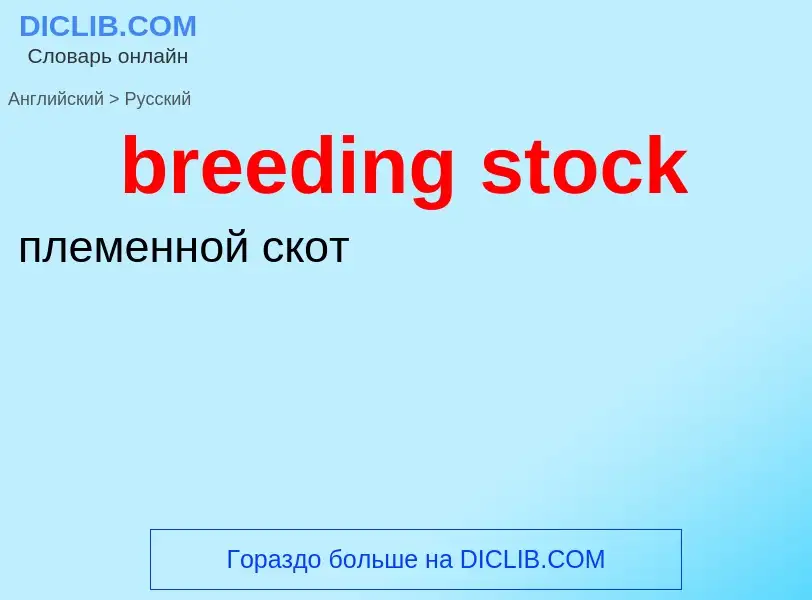Перевод и анализ слов искусственным интеллектом ChatGPT
На этой странице Вы можете получить подробный анализ слова или словосочетания, произведенный с помощью лучшей на сегодняшний день технологии искусственного интеллекта:
- как употребляется слово
- частота употребления
- используется оно чаще в устной или письменной речи
- варианты перевода слова
- примеры употребления (несколько фраз с переводом)
- этимология
breeding stock - перевод на русский
племенной скот
[ɑ:tifiʃ(ə)lsi'lekʃ(ə)n]
общая лексика
искусственный отбор
биология
селекция
общая лексика
искусственная гибридизация
['hɔ:sbri:diŋ]
общая лексика
коневодство
коневодческий
прилагательное
общая лексика
коневодческий
существительное
['hɔ:sbri:diŋ]
общая лексика
коневодство
существительное
общая лексика
коннозаводчик
коневод
['hɔ:sbri:də]
существительное
общая лексика
коневод
коннозаводчик
существительное
общая лексика
коневодство
Википедия

Selective breeding (also called artificial selection) is the process by which humans use animal breeding and plant breeding to selectively develop particular phenotypic traits (characteristics) by choosing which typically animal or plant males and females will sexually reproduce and have offspring together. Domesticated animals are known as breeds, normally bred by a professional breeder, while domesticated plants are known as varieties, cultigens, cultivars, or breeds. Two purebred animals of different breeds produce a crossbreed, and crossbred plants are called hybrids. Flowers, vegetables and fruit-trees may be bred by amateurs and commercial or non-commercial professionals: major crops are usually the provenance of the professionals.
In animal breeding, techniques such as inbreeding, linebreeding, and outcrossing are utilized. In plant breeding, similar methods are used. Charles Darwin discussed how selective breeding had been successful in producing change over time in his 1859 book, On the Origin of Species. Its first chapter discusses selective breeding and domestication of such animals as pigeons, cats, cattle, and dogs. Darwin used artificial selection as an analogy to propose and explain the theory of natural selection but distinguished the latter from the former as a separate process that is non-directed.
The deliberate exploitation of selective breeding to produce desired results has become very common in agriculture and experimental biology.
Selective breeding can be unintentional, for example, resulting from the process of human cultivation; and it may also produce unintended – desirable or undesirable – results. For example, in some grains, an increase in seed size may have resulted from certain ploughing practices rather than from the intentional selection of larger seeds. Most likely, there has been an interdependence between natural and artificial factors that have resulted in plant domestication.


![mix]] and [[Great Dane]] shows the wide range of dog breed sizes created using selective breeding. mix]] and [[Great Dane]] shows the wide range of dog breed sizes created using selective breeding.](https://commons.wikimedia.org/wiki/Special:FilePath/Big and little dog 1.jpg?width=200)
![Researchers at the [[USDA]] have selectively bred carrots with a variety of colors. Researchers at the [[USDA]] have selectively bred carrots with a variety of colors.](https://commons.wikimedia.org/wiki/Special:FilePath/Carrots of many colors.jpg?width=200)
![Selective breeding transformed [[teosinte]]'s few fruitcases (left) into modern [[maize]]'s rows of exposed kernels (right). Selective breeding transformed [[teosinte]]'s few fruitcases (left) into modern [[maize]]'s rows of exposed kernels (right).](https://commons.wikimedia.org/wiki/Special:FilePath/Cornselection.jpg?width=200)
![A [[Belgian Blue]] cow. The defect in the breed's [[myostatin]] [[gene]] is maintained through linebreeding and is responsible for its accelerated lean muscle growth. A [[Belgian Blue]] cow. The defect in the breed's [[myostatin]] [[gene]] is maintained through linebreeding and is responsible for its accelerated lean muscle growth.](https://commons.wikimedia.org/wiki/Special:FilePath/Sectio caesarea.jpg?width=200)

![The [[Thoroughbred]] industry does not allow AI or embryo transplant. The [[Thoroughbred]] industry does not allow AI or embryo transplant.](https://commons.wikimedia.org/wiki/Special:FilePath/Andrew Thornton.jpg?width=200)



![An [[artificial vagina]], used to collect semen An [[artificial vagina]], used to collect semen](https://commons.wikimedia.org/wiki/Special:FilePath/Künstliche Vagina.jpg?width=200)
![stallion]] with a proven competition record is one criterion for being a suitable sire. stallion]] with a proven competition record is one criterion for being a suitable sire.](https://commons.wikimedia.org/wiki/Special:FilePath/Totilas.jpg?width=200)
